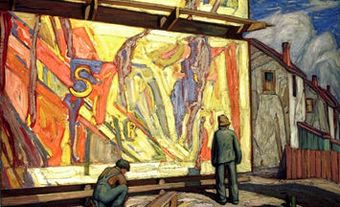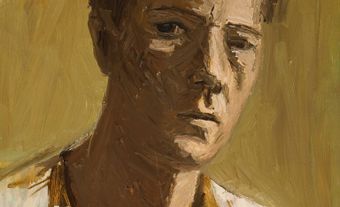Cornelius David Krieghoff
Cornelius David Krieghoff, artist (b at Amsterdam, Holland 19 June 1815; d at Chicago, Ill 8 Mar 1872). Cornelius Krieghoff's interpretations of life in mid-19th century Québec were as well-known and sought after in his own lifetime as they are today. This artist with an entrepreneurial bent was prolific: an estimated 1500 to 1800 paintings and prints suggest a ready and eager market for his images of rural francophones, aboriginal peoples, leisure sports, and landscapes and portraits. "There is hardly a Canadian home without some memento of him" claimed the artist's obituary. He was much imitated in his own time, and the enduring value of Krieghoff's works has encouraged forgery in ours. Seldom in the past 30 years has an auction of Canadian art not included at least one painting "by,""attributed to," or "after" Krieghoff.Painter in a New Land
An immigrant to North America, Krieghoff spent the better part of his youth in Protestant Schweinfurt (Bavaria, Germany), where his father managed a factory producing fine and custom wallpapers. By age 22 (1837) he had made his way across the Atlantic. He enlisted for a three-year term in the US Army and was subsequently assigned for service in the so-called Seminole Wars in Florida. His move to Canada seems to have been precipitated by familial concerns: in 1840, after first re-enlisting in the US Army, he suddenly appeared in Boucherville, the home parish of Emilie Gauthier, Krieghoff's francophone wife and mother of his newborn son.
These early civilian years were spent as an itinerant, working in the household trades (housepainting; then furniture upholstery in Rochester, NY c 1842-43) while trying to make the shift to professional artist. By 1844, in Toronto, he felt confident enough to advertise himself as "artist" and in fact garnered a major portrait commission (William Williamson and his Son Alexander, Margaret Erskine Williamson and her Daughter Jessie, both ROM collection). The following year, however, found him in Paris honing his skills, often copying works of both historical and contemporary "masters" in the Louvre and Luxembourg Museums. Back in Canada by early 1846, he established himself as a professional artist, first in Montréal until 1853, then in Québec City (1853-63). Europe appears to have been his base 1863-70; he returned briefly to Québec City (1870-71) before moving to Chicago, where he resided with his daughter until his death in 1872.
Major Themes
Krieghoff early on established in his repertoire two major themes that he would revisit throughout his career and for which he is perhaps best known: rural francophones and aboriginals. His HABITANT scenes cover a range of situations: in some, for example, folk greet one another en route, play cards, race their sleds, fraternize at the local inn, or attempt to settle a tract of un-arable land - granted to them by the government - in the hinterlands of Québec. In another typical scene, a British solider flirts with a young francophone woman, the intimate moment interrupted by her husband or a parent. In Breaking Lent (The Thomson Collection), the local priest, stern and imposing, has arrived unannounced at a parishioner's humble abode only to catch the family in the forbidden act of eating meat during Lent. Whether viewed as benign narratives or subtle, satirical commentaries on French Québec society, such genre scenes often evidence Krieghoff's awareness of the relationship between ethnic groups and/or social classes.
Krieghoff's depictions of First Nations peoples are idealized and reflect his belief in their profound attachment to the land. Despite the artist's often detailed renderings of exquisite basketry, beadwork and such other Native handiwork, the figures - always set within a landscape - are almost without exception generic. His "Indian Encampment" scenes, so categorized in an advertisement in a contemporary Montréal newspaper, are characteristic. In A Caughnawaga Indian Encampment (ROM), the figures, placed centre stage next to a wigwam beside a forest stream, represent the type "Canadian Native." Little within the image itself clearly identifies these people as those who presumably were Krieghoff's inspiration: MOHAWKs who in fact resided in their community of Caughnawaga (now Kahnawake), with its stone Catholic church and white frame homes on the south shore of the St. Lawrence opposite Lachine. In his later renditions the romantic element is heightened; the aboriginal figures camp, hunt and trek in the deep forests and waterways, but they have become mere extras, entirely subsumed by nature in all its sublime grandeur (On Lake Laurent, ROM).
Move to Québec City
Landscape, portraiture and outdoor leisure scenes assumed additional significance in Krieghoff's repertoire upon his arrival in Québec City; they provided a means to take fullest advantage of the centre's significant military and business markets as well as the burgeoning tourism and leisure trade. The area's celebrated natural monuments are the focus of many of his paintings (St. Anne Falls, NGC), while others feature the forests and rivers that were at the core of the all-important timber industry but that also served as the playground for avid outdoorsmen (Death of the Moose at Sunset, Lake Famine South of Quebec, Glenbow Collection).
Krieghoff's works could be acquired in various ways. Many paintings, and lithographs too, were sold through auction: in Montréal by J.H. Leeming, Scott & Glassford and Fisher & Armour, and in Québec City by A.J. Maxham & Company. Prints were sold by subscription through local newspapers. Booksellers sold paintings in their stores; other works were clearly the result of commissions (Fraser, with Mr Miller Up, NGC), Krieghoff's close friend John S. Budden no doubt acting as agent in several instances. The fact that a number of Krieghoff's works appeared in exhibition and for sale in Cincinnati, Philadelphia, New York City and other US centres indicates that he benefited from dealer representation south of the border.
Growing Reputation
There is evidence of Krieghoff's own entrepreneurial hand as well: his bold involvement in 1847 in the Montréal Society of Artists' exhibition, to which the artist contributed 48 paintings, more than twice that of any other participant; his submission of paintings to the Québec Provincial Exhibitions, often winning prizes; his letter attempting to convince the Hon Hamnett Pinhey to choose him to paint a portrait of Queen Victoria; an announcement in the Montréal press that he and a colleague would be creating a panorama of the Canadian landscape; and his subsequent petition to Government of Canada officials for funds to finish the project, which he pitched as a means to sell life in Canada to potential immigrants in Europe.
Most receptive to Krieghoff's imagery was the anglophone community. British military personnel collected the artist's pictures as souvenirs of their posting to the colony. Romanticized and anecdotal paintings showing the life of those "close to the land" were attractive to members of the rising North American urban middle class, as such works affirmed their newly acquired economic and social status while offering them the nostalgic assurance that traditional ways of life would continue. Works showing the richness of Canada's resources or technological advance appealed to the business elite, who saw in them evidence of and potential for economic growth and prosperity and thus a representation of their own professional interests and power.
International Attention
Recognition for Krieghoff came primarily at the local level, but in 1867 his work was chosen to represent Canada internationally. Sillery Cove (The Thomson Collection), a magnificent golden vista of one of the timber depots near Québec City, was included in Canada's display at that year's Universal Exposition in Paris. The work, its artistic qualities and important subject matter acknowledged by the Québec organizers, complemented Canada's showcase section: a display highlighting the timber industry, backbone of much of the country's wealth.
With a palette of brilliant colours, heightened gestures and facial expressions, and a realistic style and remarkable attention to detail that suggest close observation of nature, Krieghoff succeeded in creating paintings that seduced and resonated with significant segments of Canada's urban population. They provided a seemingly coherent image of Canada and thus ensured a continuing demand for his versions of "Canadian life." It has been debated whether his romanticized images of First Nations peoples and "habitants" are variously sympathetic or condescending or satirical, a debate that challenges assumptions regarding Canada's identity as a nation, both past and present. Nonetheless, his work continues to be recognized for its documentary and artistic aspects. It provides a remarkable record of one citizen's attempts to capture his perception of Canada in images, and with those images to make a name and a career as a fully professional artist in an emerging nation.
See alsoART; PAINTING: 19th AND EARLY 20TH CENTURY.

 Share on Facebook
Share on Facebook Share on X
Share on X Share by Email
Share by Email Share on Google Classroom
Share on Google Classroom



